By 1958, Toho
Company Ltd. had firmly established itself as the leading producers of the “kaiju
eiga” (monster film) genre. Starting with GOJIRA (GODZILLA) in 1954 and
following with GODZILLA RAIDS AGAIN in 1955 and RODAN (the first Japanese monster
film in color) (1956). Toho branched out with a combination space opera/giant
monster film in 1957: THE MYSTERIANS. This film was also the first to utilize
the widescreen Tohoscope process combined with vivid color and stereophonic
sound. With the exception of GODZILLA RAIDS AGAIN (directed by Motoyoshi Odo
with music by Masaru Sato), GODZILLA, RODAN and THE MYSTERIANS were produced
by the box office winning foursome of Ishiro Honda (director), Eiji Tsuburaya
(special effects director), Tomoyuki Tanaka (producer), and music maestro Akira
Ifukube. In 1958, this team combined to create another giant monster…
VARAN THE UNBELIEVABLE and now our friends at Media Blasters (who also released
beautiful DVDs of THE MYSTERIANS and ATTACK OF THE MUSHROOM PEOPLE) have unleashed
this oft overlooked little film in a gorgeous tran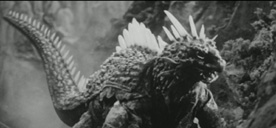 sfer
with several notable extras.
sfer
with several notable extras.
The plot of DAIKAIJU BARAN/VARAN is rather typical of giant monster-on-the loose films of the time. Two scientists on an expedition to the mountains of northern Japan search for a supposedly extinct species of butterfly when they are killed by a mysterious landslide. When a team of investigators goes out to find the cause of the disaster, the culprit makes itself known in the form of a huge lizard/dinosaur who the local natives have named Baran (Varan). Of course, the monster goes on a destructive rampage in the village and eventually makes its way to the long suffering city of Tokyo on a spectacular finale.
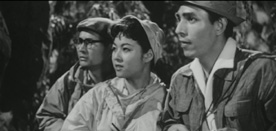 VARAN
was to be the first co-production between an American company (in this case
ABC) and Toho Company Ltd. as a film made specifically for American television.
However, ABC backed out of the project at the eleventh hour leaving the Toho
executives to make the decision to go at it alone and make it a Japanese theatrical
release. The first REAL co-production partnership was a few years in the future
with Henry G. Saperstein’s UPA Productions which co-produced some of Toho’s
greatest monster classics: FRANKENSTEIN CONQUERS THE WORLD (1965) and WAR OF
THE GARGANTUAS (1966).
VARAN
was to be the first co-production between an American company (in this case
ABC) and Toho Company Ltd. as a film made specifically for American television.
However, ABC backed out of the project at the eleventh hour leaving the Toho
executives to make the decision to go at it alone and make it a Japanese theatrical
release. The first REAL co-production partnership was a few years in the future
with Henry G. Saperstein’s UPA Productions which co-produced some of Toho’s
greatest monster classics: FRANKENSTEIN CONQUERS THE WORLD (1965) and WAR OF
THE GARGANTUAS (1966).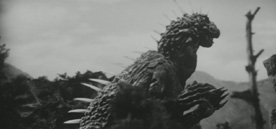
As a result of all the production headaches, there is a noticeable scaled down look in production values as compared to GODZILLA, RODAN and THE MYSTERIANS. DAIKAIJU BARAN is the first to use stock footage from the first GODZILLA. Since the first film was shot in the standard format, this footage was converted to match DAIKAIJU BARAN’s widescreen photography. In addition, the cast of DAIKAIJU BARON is mostly second tier. The first two GODZILLA films featured a great Kurosawa actor, Takashi Shimura. In DAIKAIJU BARAN, Koreya Senda plays a similar old man scientist, but rather blandly. Also, the two young male and female leads (Kozu Nomura and Ayumi Sonoda) are not as engaging as Akira Takarada and Momoko Koichi in GODZILLA or Kenji Sahara and Yumi Shirakawa in RODAN. Akihiko Hirata, who played the tortured and doomed scientist Dr. Serizawa in GODZILLA, shows up in DAIKAIJU BARAN as another scientist, but even he is rather dull here in a part that is not nearly as well written as the first GODZILLA film. Yoshio Tsuchiya, who effectively played the leader of THE MYSTERIANS and would later shine as “The Controller of Planet X” in MONSTER ZERO, also appears in DAIKAJU BARAN, but in a rather unmemorable role.
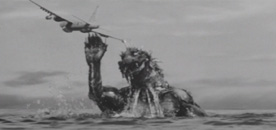 One
thing that does work in the film is Eiji Tsuburaya’s excellent special
effects (stock footage notwithstanding). The design (by Keizo Murase) of VARAN
is also unique and fairly interesting and American viewers will finally get
to see the monster take a flight!!! In 1962, DAIKAJU BARAN was bought by Crown
International Films and re-titled VARAN, THE UNBELIEVABLE. In an effort to make
the movie more palatable to U.S. audiences, new scenes shot in Hollywood featuring
B-movie veteran Myron Healy and several low rent Japanese/American actors were
filmed thus changing the a great deal of plot and placing the scenes of the
monster flying on the cutting room floor. In addition, much of the original
Japanese cast members were trimmed out of the U.S. version, where not one Japanese
crew member is credited. This Americanization was released on a double bill
with the German import, FIRST SPACESHIP ON VENUS.
One
thing that does work in the film is Eiji Tsuburaya’s excellent special
effects (stock footage notwithstanding). The design (by Keizo Murase) of VARAN
is also unique and fairly interesting and American viewers will finally get
to see the monster take a flight!!! In 1962, DAIKAJU BARAN was bought by Crown
International Films and re-titled VARAN, THE UNBELIEVABLE. In an effort to make
the movie more palatable to U.S. audiences, new scenes shot in Hollywood featuring
B-movie veteran Myron Healy and several low rent Japanese/American actors were
filmed thus changing the a great deal of plot and placing the scenes of the
monster flying on the cutting room floor. In addition, much of the original
Japanese cast members were trimmed out of the U.S. version, where not one Japanese
crew member is credited. This Americanization was released on a double bill
with the German import, FIRST SPACESHIP ON VENUS.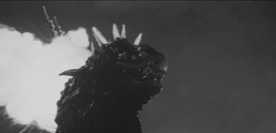
Another thing that works beautifully is the musical score (which was also cut from the U.S. version and replaced with Albert Glasser’s scores from THE AMAZING COLOSSAL MAN and TEENAGE CAVEMAN) by Akira Ifukube. Mr. Ifukube provided the haunting score for the first GODZILLA film and an even more spectacular one for THE MYSTERIANS. Now, for the first time, American viewers can listen to the music in its entirety. The musical cues are also echoed in such later Toho films as GHIDRAH: THE THREE HEADED MONSTER (1964) and FRANKENSTEIN CONQUERS THE WORLD. In fact, the familiar GHIDRAH theme (which has become a staple in the GODZILLA series) was first used in DAIKAIJU BARAN and diehard fans will recognize it immediately. The score for the opening credits is particularly rousing.
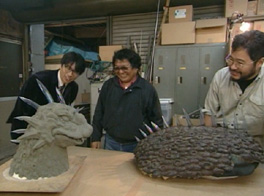 Media
Blasters has done another magnificent job in preserving the integrity of Ishiro
Honda’s original film. For those who purchased Media Blasters’ DVDs
of THE MYSTERIANS and ATTACK OF THE MUSHROOM PEOPLE, you will not be disappointed
with DAIKAIJU BARAN. The black and white transfer is sparkling clear and presented
in anamorphic (2.35:1) widescreen (Tohoscope). The audio is in Japanese language
only, in 5.1 and mono. There is a third audio track with a commentary by Keizo
Murase, who worked on the design for VARAN in 1958. Apparently, Toho did not
have the English track for DAIKAIJU BARAN that they did for the “international
version” and Media Blasters did not do a new English version as they did
on THE MYSTERIANS. The subtitles are very clear and readable throughout the
film. There is also an interesting and informative extra featuring Mr. Murase
on camera showing how he sculpted VARAN. Also, there is the original 1958 Japanese
theatrical trailer as well as promotional trailers for other Media Blasters
releases. In addition, there is a 52 minute version of DAIKAIJU BARAN which
was broadcast on Japanese television. This version is also subtitles in English.
Media
Blasters has done another magnificent job in preserving the integrity of Ishiro
Honda’s original film. For those who purchased Media Blasters’ DVDs
of THE MYSTERIANS and ATTACK OF THE MUSHROOM PEOPLE, you will not be disappointed
with DAIKAIJU BARAN. The black and white transfer is sparkling clear and presented
in anamorphic (2.35:1) widescreen (Tohoscope). The audio is in Japanese language
only, in 5.1 and mono. There is a third audio track with a commentary by Keizo
Murase, who worked on the design for VARAN in 1958. Apparently, Toho did not
have the English track for DAIKAIJU BARAN that they did for the “international
version” and Media Blasters did not do a new English version as they did
on THE MYSTERIANS. The subtitles are very clear and readable throughout the
film. There is also an interesting and informative extra featuring Mr. Murase
on camera showing how he sculpted VARAN. Also, there is the original 1958 Japanese
theatrical trailer as well as promotional trailers for other Media Blasters
releases. In addition, there is a 52 minute version of DAIKAIJU BARAN which
was broadcast on Japanese television. This version is also subtitles in English.
WOW!!! This has been a great year for Toho monster fans. Sony has been releasing some excellent widescreen transfers of the classic GODZILLA series while Media Blasters has released excellent transfers of the more offbeat Toho science fiction films with DOGORA, THE SPACE MONSTER (1964) expected in July. In November 2005, Classic Media is expected to re-release their GODZILLA titles with the addition of MONSTER ZERO which was not issued in the first batch in 2002. Hopefully, they will correct the aspect ratio problems from the first batch and release them in the proper widescreen format. Let’s hope as we go into Godzilla’s 51st year, we will see some more great titles released. (Joe Cascio)